child seat GMC YUKON 2000 Owner's Manual
[x] Cancel search | Manufacturer: GMC, Model Year: 2000, Model line: YUKON, Model: GMC YUKON 2000Pages: 413, PDF Size: 3.03 MB
Page 4 of 413
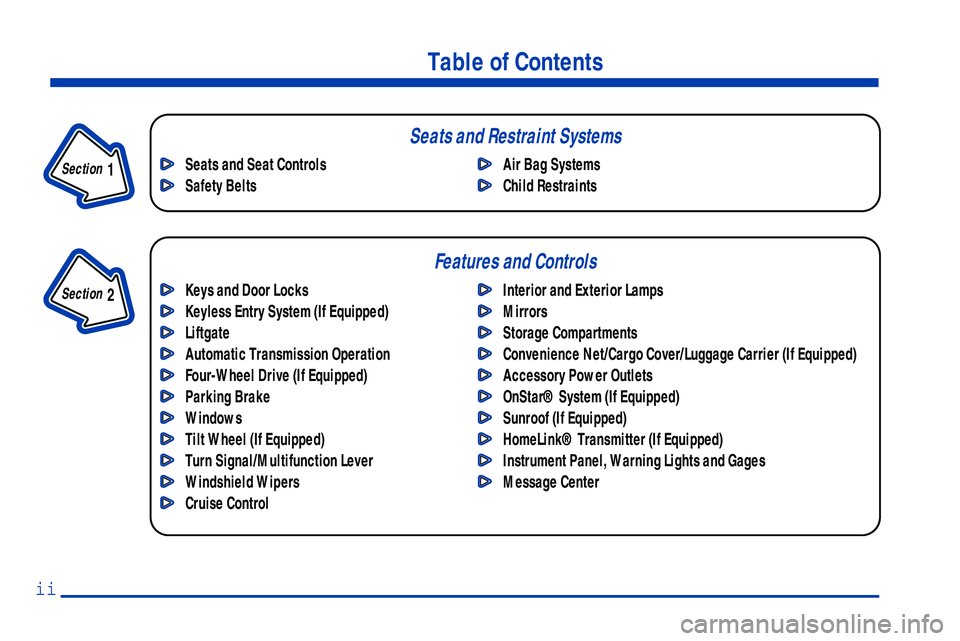
Table of Contents
Keys and Door Locks
Keyless Entry System (If Equipped)
Liftgate
Automatic Transmission Operation
Four-Wheel Drive (If Equipped)
Parking Brake
Windows
Tilt Wheel (If Equipped)
Turn Signal/Multifunction Lever
Windshield Wipers
Cruise ControlInterior and Exterior Lamps
Mirrors
Storage Compartments
Convenience Net/Cargo Cover/Luggage Carrier (If Equipped)
Accessory Power Outlets
OnStar® System (If Equipped)
Sunroof (If Equipped)
HomeLink® Transmitter (If Equipped)
Instrument Panel, Warning Lights and Gages
Message Center Seats and Seat Controls
Safety BeltsAir Bag Systems
Child Restraints
Section
1
Section
2
Seats and Restraint Systems
Features and Controls
ii
Page 14 of 413
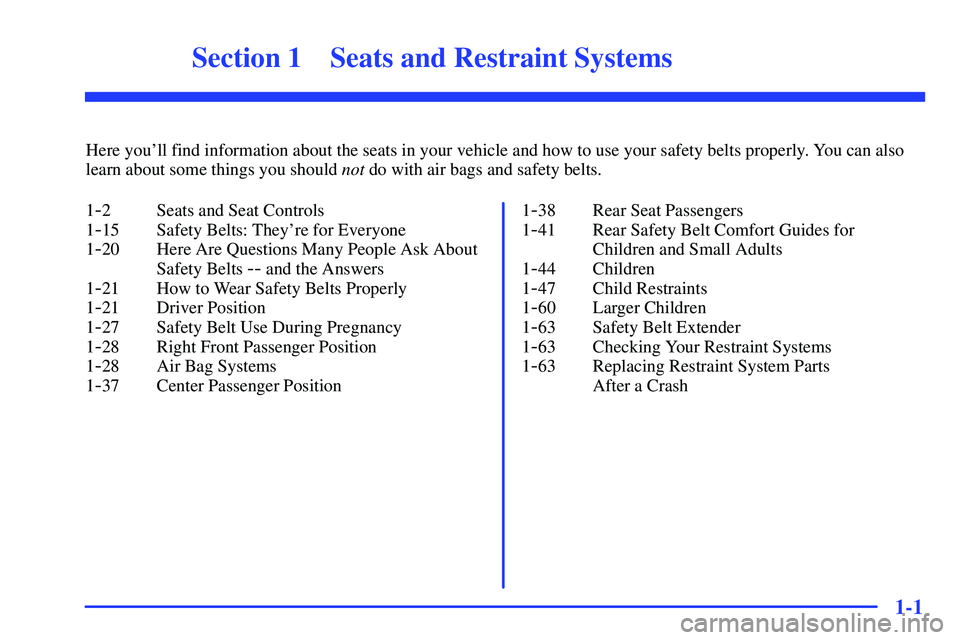
1-
1-1
Section 1 Seats and Restraint Systems
Here you'll find information about the seats in your vehicle and how to use your safety belts properly. You can also
learn about some things you should not do with air bags and safety belts.
1
-2 Seats and Seat Controls
1
-15 Safety Belts: They're for Everyone
1
-20 Here Are Questions Many People Ask About
Safety Belts
-- and the Answers
1
-21 How to Wear Safety Belts Properly
1
-21 Driver Position
1
-27 Safety Belt Use During Pregnancy
1
-28 Right Front Passenger Position
1
-28 Air Bag Systems
1
-37 Center Passenger Position1
-38 Rear Seat Passengers
1
-41 Rear Safety Belt Comfort Guides for
Children and Small Adults
1
-44 Children
1
-47 Child Restraints
1
-60 Larger Children
1
-63 Safety Belt Extender
1
-63 Checking Your Restraint Systems
1
-63 Replacing Restraint System Parts
After a Crash
Page 34 of 413
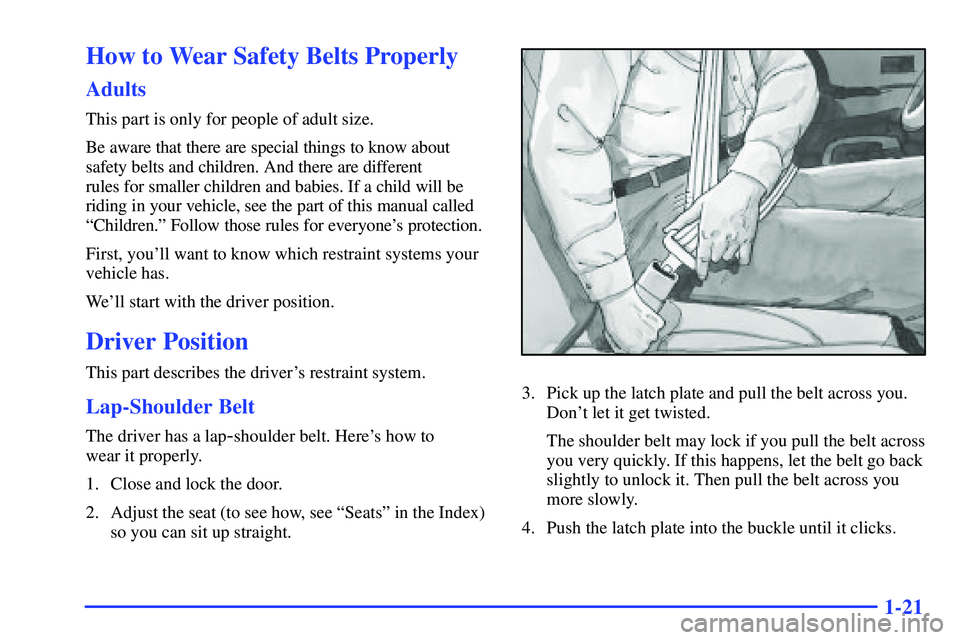
1-21
How to Wear Safety Belts Properly
Adults
This part is only for people of adult size.
Be aware that there are special things to know about
safety belts and children. And there are different
rules for smaller children and babies. If a child will be
riding in your vehicle, see the part of this manual called
ªChildren.º Follow those rules for everyone's protection.
First, you'll want to know which restraint systems your
vehicle has.
We'll start with the driver position.
Driver Position
This part describes the driver's restraint system.
Lap-Shoulder Belt
The driver has a lap-shoulder belt. Here's how to
wear it properly.
1. Close and lock the door.
2. Adjust the seat (to see how, see ªSeatsº in the Index)
so you can sit up straight.
3. Pick up the latch plate and pull the belt across you.
Don't let it get twisted.
The shoulder belt may lock if you pull the belt across
you very quickly. If this happens, let the belt go back
slightly to unlock it. Then pull the belt across you
more slowly.
4. Push the latch plate into the buckle until it clicks.
Page 54 of 413
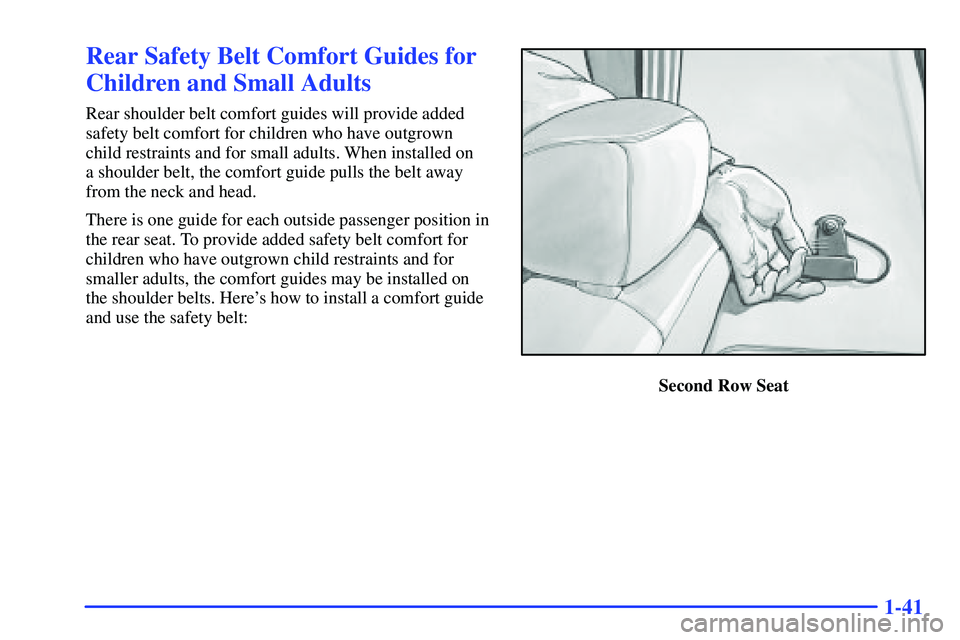
1-41
Rear Safety Belt Comfort Guides for
Children and Small Adults
Rear shoulder belt comfort guides will provide added
safety belt comfort for children who have outgrown
child restraints and for small adults. When installed on
a shoulder belt, the comfort guide pulls the belt away
from the neck and head.
There is one guide for each outside passenger position in
the rear seat. To provide added safety belt comfort for
children who have outgrown child restraints and for
smaller adults, the comfort guides may be installed on
the shoulder belts. Here's how to install a comfort guide
and use the safety belt:
Second Row Seat
Page 57 of 413
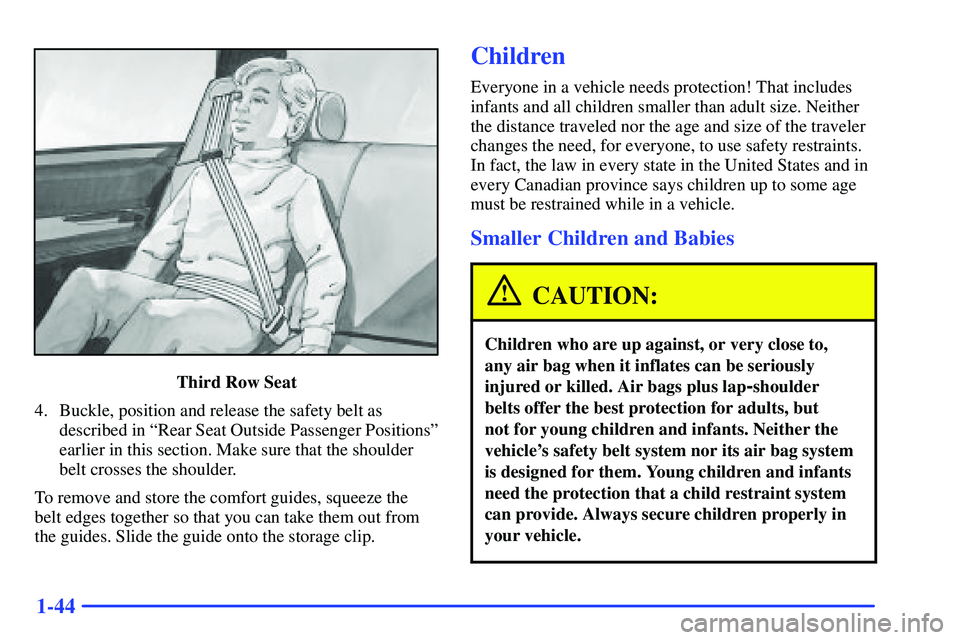
1-44
Third Row Seat
4. Buckle, position and release the safety belt as
described in ªRear Seat Outside Passenger Positionsº
earlier in this section. Make sure that the shoulder
belt crosses the shoulder.
To remove and store the comfort guides, squeeze the
belt edges together so that you can take them out from
the guides. Slide the guide onto the storage clip.
Children
Everyone in a vehicle needs protection! That includes
infants and all children smaller than adult size. Neither
the distance traveled nor the age and size of the traveler
changes the need, for everyone, to use safety restraints.
In fact, the law in every state in the United States and in
every Canadian province says children up to some age
must be restrained while in a vehicle.
Smaller Children and Babies
CAUTION:
Children who are up against, or very close to,
any air bag when it inflates can be seriously
injured or killed. Air bags plus lap
-shoulder
belts offer the best protection for adults, but
not for young children and infants. Neither the
vehicle's safety belt system nor its air bag system
is designed for them. Young children and infants
need the protection that a child restraint system
can provide. Always secure children properly in
your vehicle.
Page 62 of 413
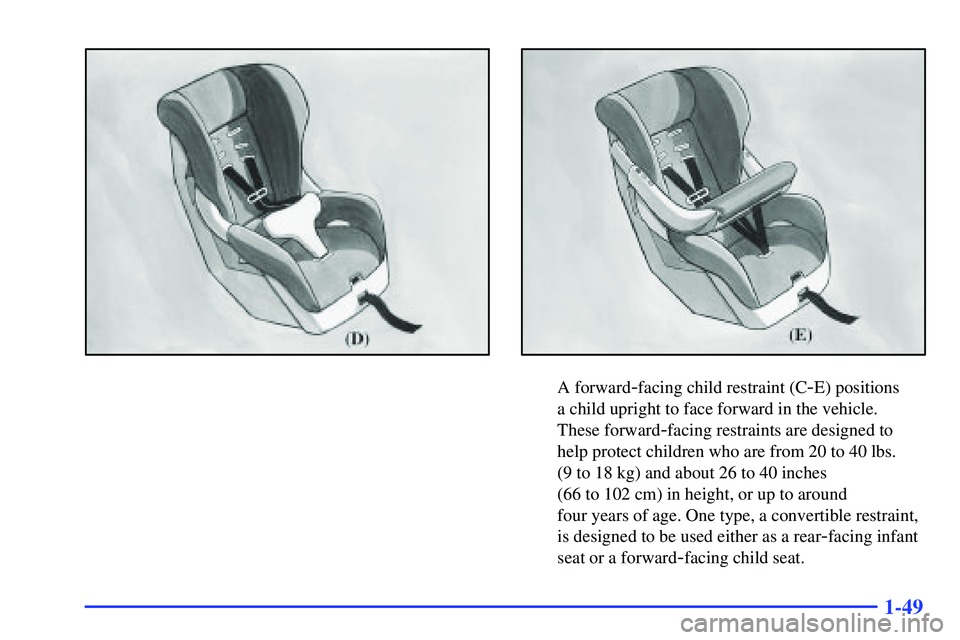
1-49
A forward-facing child restraint (C-E) positions
a child upright to face forward in the vehicle.
These forward
-facing restraints are designed to
help protect children who are from 20 to 40 lbs.
(9 to 18 kg) and about 26 to 40 inches
(66 to 102 cm) in height, or up to around
four years of age. One type, a convertible restraint,
is designed to be used either as a rear
-facing infant
seat or a forward
-facing child seat.
Page 63 of 413
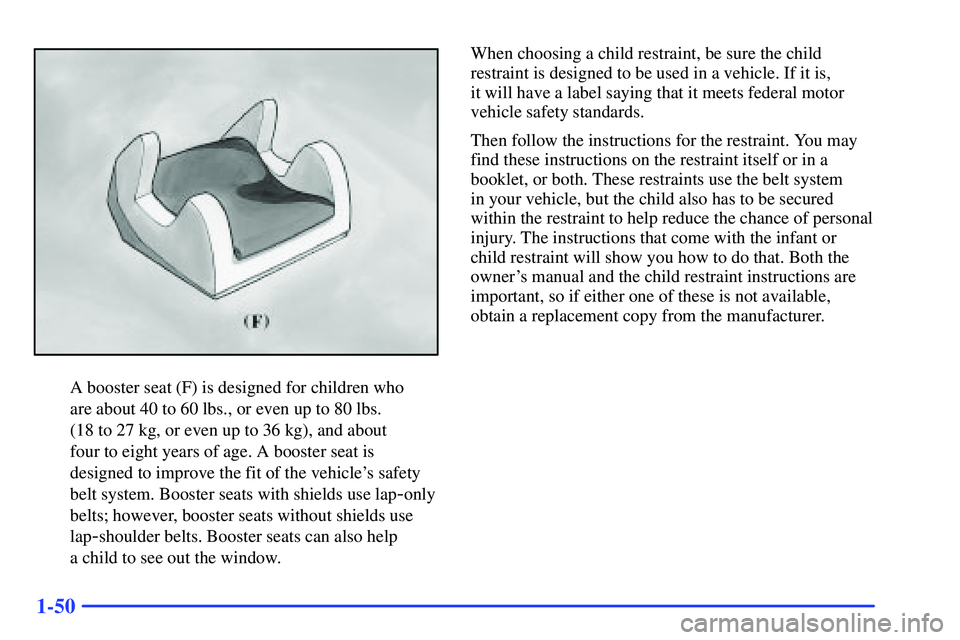
1-50
A booster seat (F) is designed for children who
are about 40 to 60 lbs., or even up to 80 lbs.
(18 to 27 kg, or even up to 36 kg), and about
four to eight years of age. A booster seat is
designed to improve the fit of the vehicle's safety
belt system. Booster seats with shields use lap
-only
belts; however, booster seats without shields use
lap
-shoulder belts. Booster seats can also help
a child to see out the window.When choosing a child restraint, be sure the child
restraint is designed to be used in a vehicle. If it is,
it will have a label saying that it meets federal motor
vehicle safety standards.
Then follow the instructions for the restraint. You may
find these instructions on the restraint itself or in a
booklet, or both. These restraints use the belt system
in your vehicle, but the child also has to be secured
within the restraint to help reduce the chance of personal
injury. The instructions that come with the infant or
child restraint will show you how to do that. Both the
owner's manual and the child restraint instructions are
important, so if either one of these is not available,
obtain a replacement copy from the manufacturer.
Page 64 of 413

1-51 Where to Put the Restraint
Accident statistics show that children are safer if they are
restrained in the rear rather than the front seat. We at
General Motors therefore recommend that you put your
child restraint in a rear seat. Never put a rear
-facing child
restraint in the right front passenger seat. Here's why:
CAUTION:
A child in a rear-facing child restraint can be
seriously injured or killed if the right front
passenger's air bag inflates. This is because the
back of the rear
-facing child restraint would be
very close to the inflating air bag. Always secure
a rear
-facing child restraint in a rear seat.
You may secure a forward-facing child restraint
in the right front seat, but before you do, always
move the front passenger seat as far back as it
will go. It's better to secure the child restraint in
a rear seat.
Wherever you install it, be sure to secure the child
restraint properly.Keep in mind that an unsecured child restraint can move
around in a collision or sudden stop and injure people
in the vehicle. Be sure to properly secure any child
restraint in your vehicle
-- even when no child is in it.
Top Strap
In Canada, the law requires that forward-facing child
restraints have a top strap, and that the strap be anchored.
In the United States, some child restraints also have a
top strap. If your child restraint has a top strap, it should
be anchored.
Page 65 of 413

1-52
Suburban/Yukon XL models without rear seats: To p
strap anchor loops are located at the bottom rear of the
front seat cushion for the right front passenger's position.
Suburban/Yukon XL Models Without Rear Seats
Anchor the top strap to this bracket. Once you have the
top strap anchored, you'll be ready to secure the child
restraint itself.Suburban/Yukon XL models with rear seats: A child
restraint with a top strap should only be used in the
second or third row. Don't use a child restraint with a
top strap in the front seat because there's no place to
anchor the top strap.
An anchor loop bracket for a top strap is located at the
bottom rear of the seat cushion for each seating position
in the second row, and for the right outside seating
position in the third row.
Suburban/Yukon XL Second Row Seat
Page 66 of 413

1-53
Suburban/Yukon XL Third Row Seat
Utility models: A child restraint with a top strap should
only be used in the second row. Don't use a child
restraint with a top strap in the right front passenger's
position or in the third row, because there's no place to
anchor the top strap.
An anchor loop bracket for a top strap is located at the
bottom rear of the seat cushion for each seating position
in the second row.Utility Second Row Seat
Anchor the top strap to this bracket. Once you have the
top strap anchored, you'll be ready to secure the child
restraint itself.